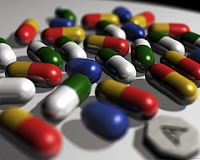Monoclonal Antibody Decoder
I've created a simple online tool, the MAB Decoder (see the top right of this page) to decode the generic name of any monoclonal antibody. For example, type in the common Crohn's medication infliximab to find from which animal species it is derived, and what part of the body it acts upon. This can be important because human-sourced antibodies are often better tolerated than those from other animals, which may influence your choice of medications. New monoclonal antibodies are being generated all the time, and often you'll see some new ones mentioned in passing. With this tool you simply enter their names to be able to learn more about them.
The MAB Decoder works with generic rather than brand names. Humira, for example, should be entered as adalimumab (the generic name of monoclonal antibodies always end in -mab). Incidentally, it is useful to be familiar with generic names because brand names may vary from country to country.
You can read more about monoclonal antibody naming at Wikipedia.
Although I created this tool to investigate Crohn's drugs, it will decipher monoclonal antibody names for all conditions. You can also try creating your own names, like humungofungomab!
